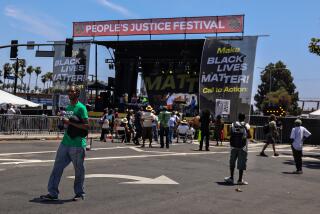Internal Struggles Leave NAACP on Political Sidelines : Civil rights: Congress’ assault on social policies dear to minorities presses ahead. It is met by silence from a group consumed by infighting, financial woes.
- Share via
WASHINGTON — As Congress’ conservative leadership moves on several fronts to scale back social policies with strong implications for minorities, the nation’s leading civil rights organization has remained mute, absorbed in its own financial troubles, lawsuits and political infighting.
For the National Assn. for the Advancement of Colored People, this painful silence becomes conspicuous as the group’s board gathers Thursday for its annual meeting in New York. Its agenda is dominated by internal concerns rather than the social issues--such as welfare reform, public housing and affirmative action--that affect many of its members.
The sessions will determine whether embattled Chairman William F. Gibson retains his position or loses it to challenger Myrlie Evers-Williams, widow of slain civil rights leader Medgar Evers. Despite questions about his financial management, Gibson is expected to win a close vote of support.
But many in the civil rights community are concerned that the board is only concerned with settling the leadership question, not plotting a course of action in the new political environment.
“The lack of a viable and strong NAACP is very damaging, not just to the NAACP but also to the civil rights movement,” said Rep. John Lewis (D-Ga.). “We need the NAACP now more than ever before to be out front, laying the foundation, laying the groundwork to take us through the ‘90s into the 21st Century. If the organization is not strong and viable, and is bogged down with internal problems, it is almost impossible for it to be effective.”
Supporters and critics agree that the NAACP ceased being an effective advocate on civil rights last summer when the board fired its executive director, Benjamin F. Chavis Jr., after learning that he had settled a sexual discrimination complaint by a female employee with $334,000 of the group’s funds.
That revelation set loose a chain of disclosures about the NAACP’s debts of nearly $3 million and plunged the group into a financial crisis after many of its corporate and philanthropic supporters refused to donate additional funds.
As the year drew to a close, the internal controversies expanded--ensnarling Gibson with allegations that he had used NAACP money for personal expenses--and prevented the organization from mounting voter-registration and get-out-the-vote programs for the Nov. 8 midterm elections. According to the Congressional Black Caucus, 70% of the nation’s registered black voters stayed home.
Although nobody claims that the NAACP could have stopped the Republican takeover of Congress, some observers believe that the civil rights group might have increased black turnout and provided a counterweight to the conservative tide.
As Lewis, a key figure in the civil rights struggles of the 1960s, said: “The NAACP is the key ingredient. It is a shame . . . in 1995 to have the makeup of this Congress and not to have the voice of the NAACP out there.”
Except for fund-raising appeals, no “statements of serious measures” have been released by the NAACP’s Baltimore headquarters since the national convention last July, said Gil Jonas, a longtime fund-raiser for the organization. “We’ve been completely gridlocked since the convention,” he said.
Despite the leadership’s lack of visibility on national social issues, the NAACP’s 2,200 branch operations have continued to press local concerns and the group’s legislative operation, headed by Washington office director Wade Henderson, has been active in behind-the-scenes efforts to influence government decisions.
“A great deal of work is going on,” said William Taylor, a Washington civil rights attorney and chairman of the Citizen Commission on Civil Rights, an organization of former federal officials that monitors government compliance with civil rights laws.
Taylor said that he has participated in meetings with Clinton Administration officials and congressional leaders at which Henderson and other civil rights leaders have attempted to plot strategies to combat GOP moves to change social policies. But such work, he admitted, occurs out of sight of the public.
“It is important that there be more visibility, more articulate and strong voices now that civil rights is under threat,” Taylor said.
Another problem for the national NAACP is that its membership tends to learn of its recent activities through negative media reports that focus on the group’s internal difficulties. For example, a recent broadcast of CBS’ “60 Minutes” featured a report on the NAACP’s internal problems with the emphasis on the differing opinions of Gibson and Evers-Williams. Additionally, syndicated columnist Carl Rowan has written a steady stream of critical articles with the clear intent of persuading board members to replace Gibson and his supporters.
Evers-Williams heads the roster of influential NAACP members challenging Gibson’s leadership. Others in her group include former board member Julian Bond, former NAACP President Hazel Dukes and Joe Madison, a Washington-area radio talk show host.
Evers-Williams cited the legacy of her late husband, a crusading national field director who was killed in 1963 as he organized NAACP branches in Mississippi.
NAACP insiders representing both camps said the vote for chairman is a dead heat, with both sides giving Gibson the advantage because of his long influence over many of the board members.
At the weekend board meeting, however, the NAACP’s leadership--regardless of which slate wins--is unlikely to offer any public agenda for dealing with current political issues.
“You can’t help but notice that the coherent national voice (of the NAACP) is not as consistent as it has been in the past,” said a longtime civil rights activist. “I’m afraid that sorry state of affairs will continue, at least until the somewhat unresolved state of affairs within the organization is settled.”
More to Read
Sign up for Essential California
The most important California stories and recommendations in your inbox every morning.
You may occasionally receive promotional content from the Los Angeles Times.













